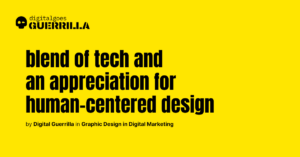In the fast-paced world of digital marketing, staying ahead means leveraging every tool available to captivate audiences. For years, graphic design has been a cornerstone of marketing success, but traditional design processes can be time-consuming and resource-intensive. Enter artificial intelligence (AI): a game-changer that’s reshaping how marketers approach design.
But while many are familiar with AI’s basic applications, fewer understand how to fully harness its potential for digital marketing campaigns. In this guide, we’ll delve into advanced ways to use AI in graphic design, uncovering lesser-known strategies that can elevate your creative efforts while maximizing efficiency. Whether you’re a marketer, a designer, or a business owner, you’ll learn actionable insights to integrate AI into your workflow and stay ahead of the curve.
The New Frontier: How AI Transforms Graphic Design for Digital Marketing
AI is more than just a time-saver; it’s a tool for creativity and strategy. By understanding how AI fits into each stage of the design process, you can tap into its transformative power to create visually stunning, highly personalized, and on-brand marketing materials.
1. Automating Routine Design Tasks to Boost Efficiency
AI excels at handling repetitive design tasks like resizing images, generating variations, and creating templates. Tools like Canva’s Magic Resize or Figma’s AI plugins allow designers to focus on creative strategy while AI handles the tedious details.
Example: A digital agency used AI to create multiple banner ad variations tailored to different audience segments, reducing production time by 70%. The result? A more targeted campaign that boosted click-through rates by 25%.
2. Creating Data-Driven, Personalized Visuals
Today’s consumers expect personalized experiences. AI tools like Adobe Sensei analyze user data to create visuals tailored to specific audiences. Imagine automatically generating a social media post that aligns with a user’s preferences, browsing history, or even current trends.
Actionable Tip: Integrate AI-powered audience insights from tools like Hootsuite Insights or Google Analytics to inform your graphic designs. For example, color schemes and layouts can be adjusted based on audience demographics or cultural preferences.
3. AI-Generated Design Ideas: Spark Creativity with Assistance
AI doesn’t replace creativity—it amplifies it. Tools like DALL-E and RunwayML can generate unique design concepts based on text prompts. These platforms are perfect for brainstorming sessions or exploring unconventional ideas.
Example: A marketing team used MidJourney to generate concept art for a campaign, refining the AI-generated visuals into a final design that resonated with their audience.
4. Optimizing Social Media Graphics with AI
The fast-moving nature of social media demands rapid content creation. AI tools like Lumen5 and Kapwing automate the production of social media graphics, ensuring visuals are optimized for platform-specific requirements.
Pro Insight: Pair AI-generated designs with A/B testing tools to identify which visuals perform best. For instance, test two AI-created Instagram ads to determine the ideal combination of colors, fonts, and imagery.
5. Enhancing Brand Consistency Across Campaigns
Maintaining brand consistency across platforms and campaigns is crucial. AI-powered design tools like Brandfolder and Frontify ensure your visuals adhere to brand guidelines, automatically applying approved colors, fonts, and styles.
Actionable Framework:
- Upload your brand assets into an AI-powered brand management tool.
- Set design rules for logos, color palettes, and fonts.
- Let AI suggest or auto-correct designs that stray from your guidelines.
Tools That Make It Happen: Essential AI Design Platforms
Here’s a quick list of AI-powered tools to incorporate into your digital marketing design workflow:
- Canva AI: Easy-to-use design automation.
- Adobe Firefly: Advanced generative AI for creatives.
- Looka: AI-powered branding and logo creation.
- Hotpot.ai: Quick mockups and social media visuals.
- Designify: Instant background removal and photo enhancements.
Each of these tools can save time, enhance creativity, or optimize designs for performance.
The Ethical Side of AI in Design: What You Need to Know
As AI becomes integral to design, ethical considerations are critical. Always credit AI-generated work transparently, and ensure your designs respect copyrights and intellectual property laws. Platforms like DeepAI provide detailed licensing information to help you navigate these challenges.
FAQs: Common Questions About AI in Graphic Design
Can AI replace human designers?
AI complements human creativity but cannot replicate the nuanced understanding of branding and storytelling that designers bring. It’s a tool, not a replacement.
Is AI in design cost-effective?
Yes, AI can reduce costs by automating time-intensive tasks and eliminating the need for outsourcing repetitive work.
How do I start using AI for graphic design?
Begin by integrating free tools like Canva AI into smaller projects. Gradually explore advanced options like Adobe Firefly for larger campaigns.
Conclusion: Elevate Your Digital Marketing with AI-Driven Design
AI is revolutionizing the world of graphic design, offering tools to streamline processes, inspire creativity, and create personalized content. By integrating AI strategically, digital marketers can unlock new levels of efficiency and impact.
The future of digital marketing is here, and it’s powered by AI. Start experimenting with the tools and strategies discussed in this post, and watch your campaigns achieve new heights.
